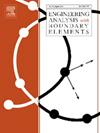基于b样条插值的高效流形进化算法
IF 4.1
2区 工程技术
Q1 ENGINEERING, MULTIDISCIPLINARY
Engineering Analysis with Boundary Elements
Pub Date : 2025-10-01
DOI:10.1016/j.enganabound.2025.106488
引用次数: 0
摘要
本文探讨了光滑流形上点云数据演化的一种有效拉格朗日方法。在这项初步研究中,我们的重点是分析平面曲线,我们的最终目标是为高维流形提供一种替代传统径向基函数(RBF)方法的方法。特别地,我们使用b样条作为所有局部插值的基函数。就像RBF和其他光滑基函数一样,b样条可以逼近几何特征,如法向量和曲率。一旦正确设置,使用b样条的优点是它们的系数具有几何意义。这允许系数像点一样被操纵,便于插值器的快速更新,并消除了频繁重新插值的需要。因此,点云数据的移除和插入成为无缝过程,在点密度波动较大的地区尤其有利。数值结果证明了几何量的收敛性和方法的有效性。最后,我们展示了曲率流的模拟,其速度依赖于耦合反应-扩散系统的解来形成图案。本文章由计算机程序翻译,如有差异,请以英文原文为准。
Efficient manifold evolution algorithm using adaptive B-Spline interpolation
This paper explores an efficient Lagrangian approach for evolving point cloud data on smooth manifolds. In this preliminary study, we focus on analyzing plane curves, and our ultimate goal is to provide an alternative to the conventional radial basis function (RBF) approach for manifolds in higher dimensions. In particular, we use the B-Spline as the basis function for all local interpolations. Just like RBF and other smooth basis functions, B-Splines enable the approximation of geometric features such as normal vectors and curvature. Once properly set up, the advantage of using B-Splines is that their coefficients carry geometric meanings. This allows the coefficients to be manipulated like points, facilitates rapid updates of the interpolant, and eliminates the need for frequent re-interpolation. Consequently, the removal and insertion of point cloud data become seamless processes, particularly advantageous in regions experiencing significant fluctuations in point density. The numerical results demonstrate the convergence of geometric quantities and the effectiveness of our approach. Finally, we show simulations of curvature flows whose speeds depend on the solutions of coupled reaction–diffusion systems for pattern formation.
求助全文
通过发布文献求助,成功后即可免费获取论文全文。
去求助
来源期刊

Engineering Analysis with Boundary Elements
工程技术-工程:综合
CiteScore
5.50
自引率
18.20%
发文量
368
审稿时长
56 days
期刊介绍:
This journal is specifically dedicated to the dissemination of the latest developments of new engineering analysis techniques using boundary elements and other mesh reduction methods.
Boundary element (BEM) and mesh reduction methods (MRM) are very active areas of research with the techniques being applied to solve increasingly complex problems. The journal stresses the importance of these applications as well as their computational aspects, reliability and robustness.
The main criteria for publication will be the originality of the work being reported, its potential usefulness and applications of the methods to new fields.
In addition to regular issues, the journal publishes a series of special issues dealing with specific areas of current research.
The journal has, for many years, provided a channel of communication between academics and industrial researchers working in mesh reduction methods
Fields Covered:
• Boundary Element Methods (BEM)
• Mesh Reduction Methods (MRM)
• Meshless Methods
• Integral Equations
• Applications of BEM/MRM in Engineering
• Numerical Methods related to BEM/MRM
• Computational Techniques
• Combination of Different Methods
• Advanced Formulations.
 求助内容:
求助内容: 应助结果提醒方式:
应助结果提醒方式:


